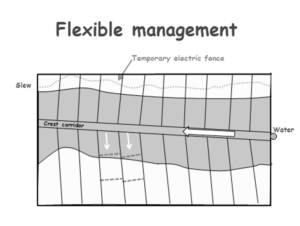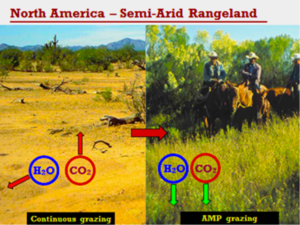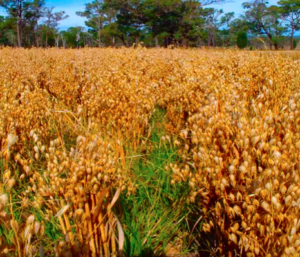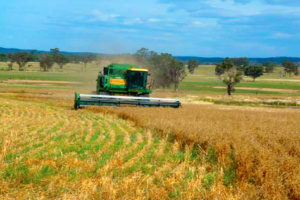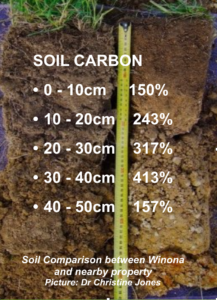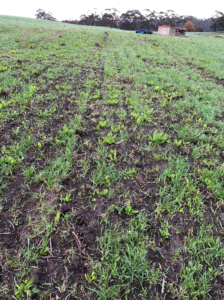Regenerative Food and Farming: Survival and Revival
“Regenerative agriculture provides answers to the soil crisis, the food crisis, the climate crisis, and the crisis of democracy.” Dr. Vandana Shiva, Co-Founder Regeneration International
Regenerative agriculture and holistic livestock management represent the next, crucial stage of organic food and farming, not only avoiding toxic pesticides, fertilizers, sewage sludge, GMO seeds, and excessive greenhouse gas emissions, but regenerating soil fertility, water retention, carbon sequestration, and rural livelihoods as well.
Regeneration has now become the hottest topic in the natural and organic food sector. At the same time, climate activists regularly discuss the role of organic and regenerative practices in reducing agricultural greenhouse gas emissions and sequestering excess atmospheric carbon dioxide in soils and agricultural landscapes.
Inside Regeneration International, which now includes 400 affiliates in more than 60 countries, our primary focus is moving beyond the basics of Regeneration to identifying regenerative and organic “best practices” around the globe and figuring out how to utilize farmer innovation, marketplace demand, policy reform, and public and private investing to qualitatively spread and scale these best practices up so that organic and regenerative becomes the norm, rather than just the alternative, for the planet’s now degenerative multitrillion-dollar food, farming and land use system.
Either we move beyond merely treating the symptoms of our planetary degeneration and build instead a new system based upon regenerative food, farming and land use, coupled with renewable energy practices and global cooperation instead of superpower competition and belligerence, or we will soon pass the point of no return.
In 2010 Olaf Christen stated, “Regenerative agriculture is an approach in agriculture that rejects pesticides and synthetic fertilizers and is intended to improve the regeneration of the topsoil, biodiversity and the water cycle.”
This corresponds almost exactly with the stated principles of the International Federation of Organic Agriculture Movements (IFOAM) or Organics International.
Since 2014, the Rodale Institute, IFOAM, Dr. Bronner’s, Dr. Mercola, Patagonia, the Real Organic Project, the Biodynamic Movement, the Organic Consumers Association, Regeneration International, Navdanya and others have also been discussing and implementing organic standards, practices and certification, which incorporate regenerative principles.
Changing the Conversation: Regenerative Food and Farming
In September 2014 a group of food, natural health and climate activists, including Vandana Shiva, Andre Leu, Will Allen, Steve Rye, Alexis Baden-Meyer and staff from Dr. Bronner’s, Dr. Mercola, Organic Consumers Association and the Rodale Institute, organized a press conference at the massive climate march in New York City to announce the formation of Regeneration International and to set for ourselves a simple, but what seemed like then ambitious, goal.
We all pledged to change the conversation on the climate crisis in the U.S. and around the world — then narrowly focused on renewable energy and energy conservation — so as to incorporate regenerative and organic food, farming and land use as a major solution to global warming, given its proven ability to drawdown and sequester massive amounts of excess carbon dioxide from the atmosphere and store it in the soil, trees, and plants.
Now, seven years later, it appears that our growing Regeneration Movement has achieved this goal. Regeneration is now the hottest topic in the natural and organic food and farming sector, while climate activists including the Sunrise Movement and Extinction Rebellion regularly talk about the role of organic and regenerative practices in reducing agricultural greenhouse gas emissions.
More and more people now understand that we can achieve, through enhanced photosynthesis and drawdown, “Net Zero” emissions by 2030, a figure will be necessary if we are to avoid runaway global warming and climate catastrophe.
Identifying Regenerative and Organic ‘Best Practices’
Inside Regeneration International, which now includes 400 affiliates in more than 60 countries, our conversation has shifted from promoting a basic discussion about organic and regenerative food, farming, and land-use to identifying regenerative and organic “best practices” around the globe.
Our discussions and strategizing are not just an academic exercise. As most of us now realize, our very survival as a civilization and a species is threatened by a systemic crisis that has degraded climate stability, our food and our environment, along with every major aspect of modern life.
This mega-crisis cannot be resolved by piecemeal reforms or minor adjustments such as slightly cutting our current levels of fossil fuel use, reducing global deforestation, soil degradation and military spending.
Either we move beyond merely treating the symptoms of our planetary degeneration and build instead a new system based upon regenerative food, farming and land use, coupled with renewable energy practices and global cooperation instead of belligerence, or we will soon (likely within 25 years) pass the point of no return.
A big challenge is how do we describe the crisis of global warming and severe climate change in such a way that everyday people understand the problem and grasp the solution that we’re proposing, i.e., renewable energy and regenerative food, farming and land use?
Enhanced Photosynthesis Is All-Important
The bottom line is that humans have put too much CO2 and other greenhouse gases (especially methane and nitrous oxide) into the atmosphere (from burning fossil fuels and destructive land use), trapping the sun’s heat from radiating back into space and heating up the planet.
And, unfortunately, because of the destructive food, farming and forestry practices that have degraded a major portion of the Earth’s landscape, we’re not drawing down enough of these CO2 emissions through plant photosynthesis, soil carbon sequestration, and perennial above ground carbon storage in biomass (forest, grass, and plants) to cool things off.
In a word, there’s too much CO2 and greenhouse gas pollution blanketing the sky (and saturating the oceans) and not enough life-giving carbon in the ground and in our living plants, trees, pastures, and rangelands.
Increasing plant and forest photosynthesis (accomplished via enhanced soil fertility and biological life, as well as an adequate amount of water and minerals) is the only practical way that we can draw down a significant amount of the excess CO2 and greenhouse gases in our atmosphere that are heating up the Earth and disrupting our climate.
Through photosynthesis, plants and trees utilize solar energy to break down CO2 from the atmosphere, release oxygen, and transform the remaining carbon into plant biomass and liquid carbon.
Photosynthesis basically enables plants to grow above ground and produce biomass, but also stimulates growth below ground as plants transfer a portion of the liquid carbon they produce through photosynthesis into their root systems to feed the soil microorganisms that in turn feed the plant.
From the standpoint of drawing down enough CO2 and greenhouse gases from the atmosphere and sequestering them in our soils and biota to reverse global warming, qualitatively enhanced photosynthesis is all-important.
Agave Power: Greening the Desert
As RI, OCA, and our Mexico affiliate Via Organica’s contribution to the global expansion of regenerative and organic food and farming practices, we have spent the last several years working with Mexican farmers and ranchers, the Hudson Carbon Project, consumer organizations, elected political officials (mainly at the local and state level), and socially and environmentally-concerned “impact investors.”
Our goal is to develop a native agave agroforestry and livestock management system that we believe can be a game-changer for much of the 40% of the world’s pasturelands and rangelands that are arid and semi-arid, areas where it is now nearly impossible to grow food crops without irrigation, and where the land is too overgrazed and degraded for proper livestock grazing.
We call this Mexico-based agave and agroforestry/livestock management system Agave Power: Greening the Desert, and are happy to report that its ideas and practices are now starting to spread from the high desert plateau of Guanajuato across much of arid and semi-arid Mexico.
We now are receiving inquiries and requests for information about this agave-based, polyculture/perennial system from desert and semi-desert areas all over the world, including Central America, the Southwestern U.S., Argentina, Chile, Zimbabwe, South Africa, Australia, Lebanon, and Oman.
You can learn more about this Agave Power system on the websites of Regeneration International and the Organic Consumers Association.
Primary Drivers of Regeneration and Degeneration
What I and others have learned “on the ground” trying to expand and scale-up regenerative and organic best practices is that there are four basic drivers of regenerative (or conversely degenerative) food, farming and land use.
The first driver is consumer awareness and market demand. Without an army of conscious consumers and widespread market demand, regenerative practices are unlikely to reach critical mass. The second driver is farmer, rancher and land stewardship innovation, including the development of value-added products and ecosystem restoration services.
The third driver is policy change, starting at the local and regional level. And last, but not least is regenerative finance — large-scale investing on the part of the public and private sector, what is now commonly known as “impact investing.”
In order to qualitatively expand organic and regenerative best practices and achieve critical mass sufficient to transform our currently degenerative systems, we need all four of these drivers to be activated and working in synergy.
Let’s look now at four contemporary drivers of degeneration, degenerative food, farming and land use, in order to understand what the forces or drivers are that are holding us back from moving forward to regeneration.
1-Degenerated grassroots consciousness and morale — When literally billions of people, a critical mass of the 99%, are hungry, malnourished, and/or stuffed and supersized with ultraprocessed foods and empty calories, revolution is all but impossible. When billions are scared and divided, struggling to survive with justice and dignity… when the majority of the global body politic are threatened and assaulted by a toxic environment and food system; when hundreds of millions are overwhelmed by economic stress due to low wages and the high cost of living; when hundreds of millions are weakened by chronic health problems, or battered by floods, droughts and weather extremes, regenerative change — Big Change — will not come easily.
Neither will it happen if we continue to allow endless wars and land grabs for water, land and strategic resources to spiral out of control, or fail to organize and resist on a mass scale while indentured politicians, corporations, Big Tech, and the mass media manipulate crises such as COVID-19 to stamp out freedom of expression and participatory democracy in order to force a “Business-as-Usual” or “Great Reset” paradigm down our throats.
Disempowered, exploited people, overwhelmed by the challenges of everyday survival, usually don’t have the luxury of connecting the dots between the issues that are pressing down on them and focusing on the Big Picture.
It’s the job of regenerators to connect the dots between the climate crisis, COVID-19, elite control and people’s everyday concerns including food, natural health, jobs, and economic justice, to globalize awareness, political mobilization and, most of all, to globalize hope.
It’s the job of regenerators to make the connections between personal and public health and planetary health, to expose the truth about the origins, nature, prevention and treatment of COVID-19 and chronic disease, and to mobilize the public to reject a so-called Great Reset disguised as fundamental reform, but actually a Trojan Horse for a 21st Century Technocracy that is profoundly antidemocratic and authoritarian.
Regenerators have to be able to make the connections between different issues and concerns, identify and support best practitioners and policies and build synergy between social forces, effectively lobby governments (starting at the local level), businesses and investors for change, all the while educating and organizing grassroots alliances and campaigns across communities, constituencies and even national borders.
But of course this long-overdue Regeneration Revolution will not be easy, nor will it take place overnight. Our profoundly destructive, degenerative, climate-destabilizing food and farming system, primarily based upon industrial agriculture inputs and practices, is held together by a multibillion-dollar system of marketing and advertising that has misled or literally brainwashed a global army of consumers into believing that cheap, ultra-processed, artificially flavored, “fast food” is not only acceptable, but “normal” and “natural.”
After decades of consuming sugar, salt, carbohydrate-rich and “bad fat”-laden foods from industrial farms, animal factories and chemical manufacturing plants, many consumers have literally become addicted to the artificial flavors and aromas that make super-processed foods and “food-like substances” so popular.
2-Degenerate “conventional” farms, farming and livestock management
Compounding the lack of nutritional education, choice, poverty, inertia and apathy of a large segment of consumers, other major factors driving our degenerative food and farming system include the routine and deeply institutionalized practices of industrial and chemical-intensive farming and land use (mono-cropping, heavy plowing, pesticides, chemical fertilizers, GMOs, factory farms, deforestation, wetlands destruction) today.
These soil-, climate-, health- and environmentally-destructive practices are especially prevalent on the world’s 50 million large farms, which, in part, are kept in place by global government subsidies totaling $500 billion a year.
Meanwhile, there are few or no subsidies for organic or regenerative farmers, especially small farmers (80% of the world’s farmers are small farmers), nor for farmers and ranchers who seek to make this transition.
Reinforcing these multibillion-dollar subsidies for bad farming practices are a global network of chemical- and agribusiness-controlled agricultural research and teaching institutions, focused on producing cheap food and beverages (no matter what the cost to the environment, climate and public health) and agro-export agricultural commodities (often pesticide-intensive GMO grains).
What we need instead are subsidies for organic and regenerative practices, research and technical assistance for farmers and ranchers to produce healthy, organic and regenerative food for local, regional and domestic markets, rewarding farmers with a fair price for producing healthy food and being a steward, rather than a destroyer, of the environment.
3-Monopoly Control — Another driver of degeneration, holding back farmer adoption of regenerative practices and determining the type of food and crops that are produced, is the monopoly or near-monopoly control by giant agribusiness corporations over much of the food system, especially in industrialized countries, as well as the monopoly or near-monopoly control by giant retail chains such as Walmart and internet giants like Amazon.
The out-of-control “Foodopoly” that dominates our food system is designed to maximize short-term profits and exports for the large transnational corporations, preserve patents and monopoly control over seeds, and uphold international trade agreements (NAFTA, WTO) that favor corporate agribusiness and large farms over small farms; factory farms over traditional grazing and animal husbandry; and agro- exports instead of production for local and regional markets.
Food and farming is the largest industry in the world with consumers spending an estimated $7.5 trillion a year on food. In addition, the largely unacknowledged social, environmental and health costs (i.e., collateral damage) of the industrial food chain amounts to an additional $4.8 trillion a year.
4-Degenerate public policy and public and private investments
Agriculture is the largest employer in the world with 570 million farmers and farm laborers supporting 3.5 billion people in rural households and communities. In addition to workers on the farm, food chain workers in processing, distribution and retail make up hundreds of millions of other jobs in the world, with over 20 million food chain workers in the U.S. alone (17.5% of the total workforce).
This makes public policy relating to food, farming and land use very important. Unfortunately, thousands of laws and regulations are passed every year, in every country and locality, that basically prop up conventional (i.e., industrial, factory farm, export-oriented, GMO) food and farming, while there is very little legislation passed or resources geared toward promoting organic and regenerative food and farming.
Trillions of dollars have been, and continue to be, invested in the so-called “conventional” food and farming sector, including trillions from the savings and pension funds of many conscious consumers, who would no doubt prefer their savings to be invested in a different manner, if they knew how to do this.
Unfortunately, only a tiny percentage of public or private investment is currently going toward organic, grass fed, free-range and other healthy foods produced by small and medium-sized farms and ranches for local and regional consumption.
Healthy soil, healthy plants, healthy animals, healthy people, healthy climate, healthy societies — our physical and economic health, our very survival as a species, are directly connected to the soil, biodiversity and the health and fertility of our food and farming systems. Regenerative organic farming and land use can move us back into balance, back to a stable climate and a life-supporting environment.
It’s time to move beyond degenerate ethics, farming, land use, energy policies, politics and economics. It’s time to move beyond “too little, too late” mitigation and sustainability strategies. It’s time to inspire and mobilize a mighty global army of Regenerators, before it’s too late.
Ronnie Cummins is co-founder of the Organic Consumers Association (OCA) and Regeneration International. To keep up with RI’s news and alerts, sign up here.

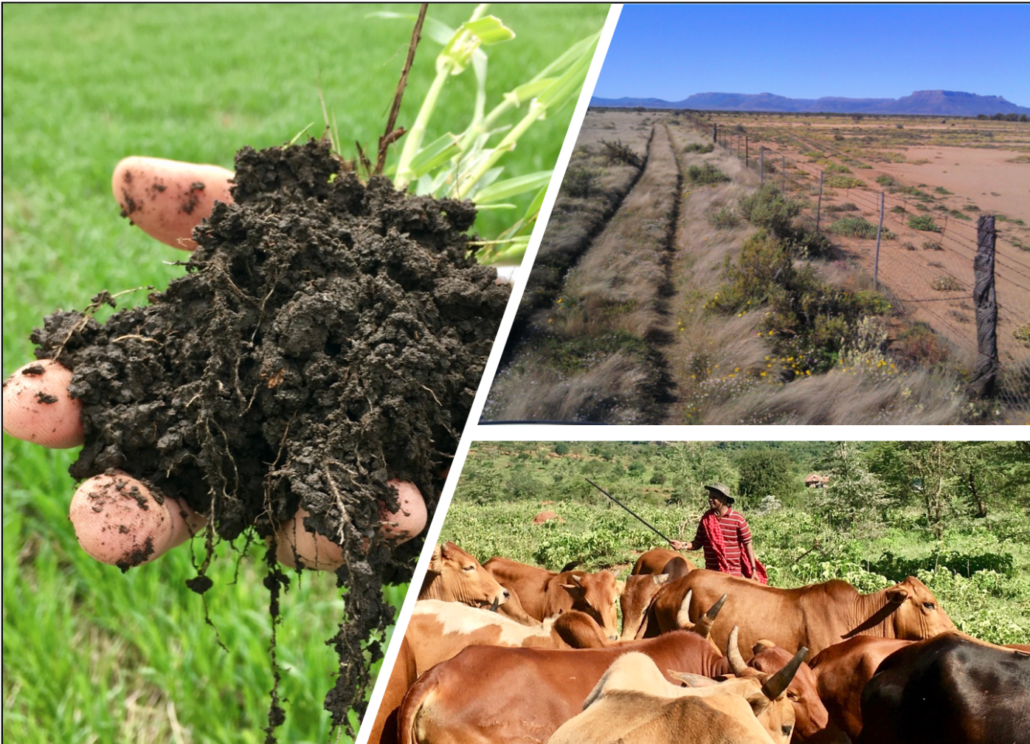
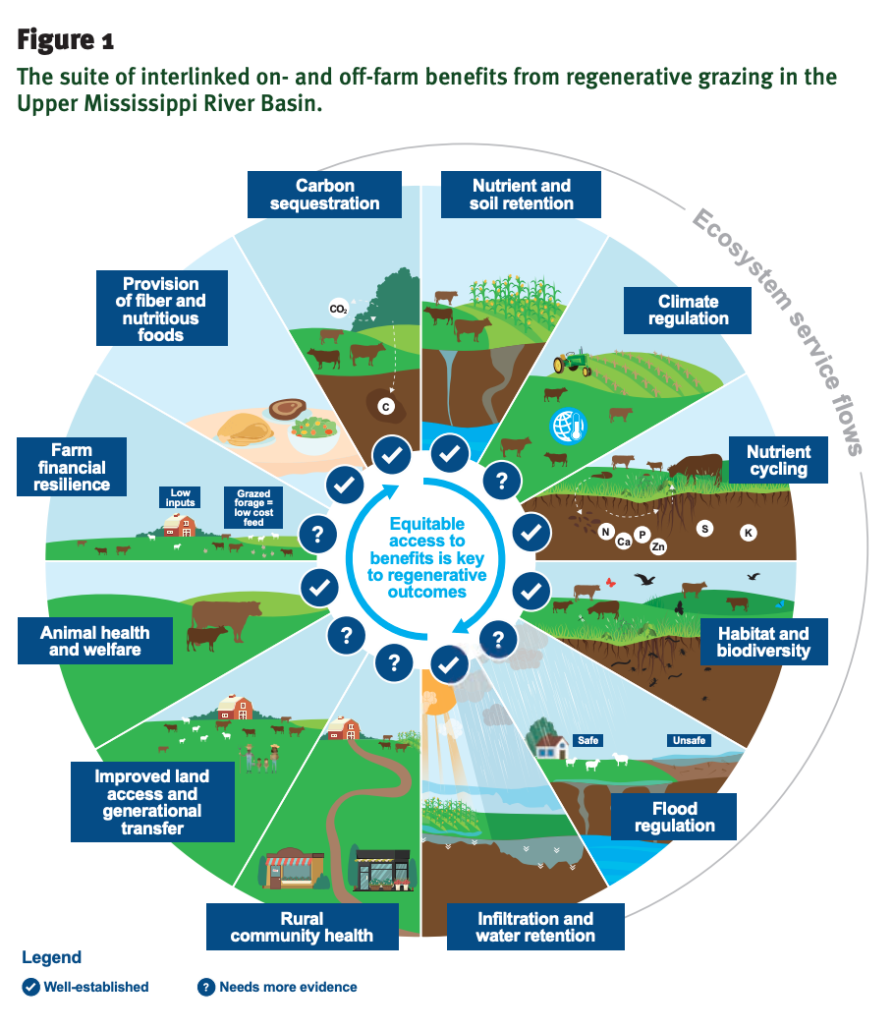 2021 Viewpoint by Spratt et al. in the Journal of Soil and Water Conservation defines “regenerative grazing” as a “win-win-win” component of “regenerative agriculture” that “uses soil health and adaptive livestock management principles to improve farm profitability, human and ecosystem health, and food system resiliency.”
2021 Viewpoint by Spratt et al. in the Journal of Soil and Water Conservation defines “regenerative grazing” as a “win-win-win” component of “regenerative agriculture” that “uses soil health and adaptive livestock management principles to improve farm profitability, human and ecosystem health, and food system resiliency.”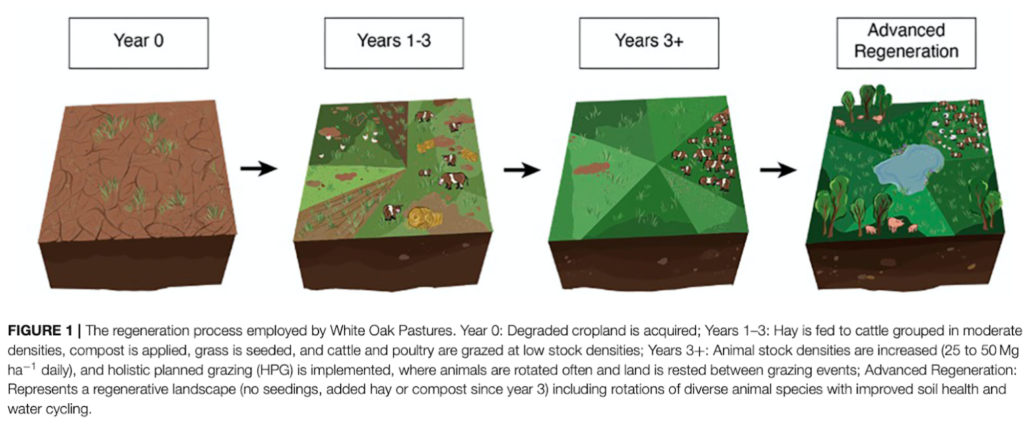 2020 paper by Rowntree et al. documents the soil carbon increases from “holistic planned grazing” in a multi-species pasture rotation (MSPR) system on the USDA-certified organic White Oak Pastures farm in Clay County, Georgia. Over 20 years, the farm sequestered an average of 2.29 metric tonnes of carbon per hectare per year (2.29 Mg C/ha/yr). The paper also shows that the area required to produce food in this regenerative way was 2.5 times that of conventional farming (which would have resulted in soil degradation and toxic chemicals impact). It notes that production efficiency comes at a cost of “land-use tradeoffs” that must be taken into consideration.
2020 paper by Rowntree et al. documents the soil carbon increases from “holistic planned grazing” in a multi-species pasture rotation (MSPR) system on the USDA-certified organic White Oak Pastures farm in Clay County, Georgia. Over 20 years, the farm sequestered an average of 2.29 metric tonnes of carbon per hectare per year (2.29 Mg C/ha/yr). The paper also shows that the area required to produce food in this regenerative way was 2.5 times that of conventional farming (which would have resulted in soil degradation and toxic chemicals impact). It notes that production efficiency comes at a cost of “land-use tradeoffs” that must be taken into consideration.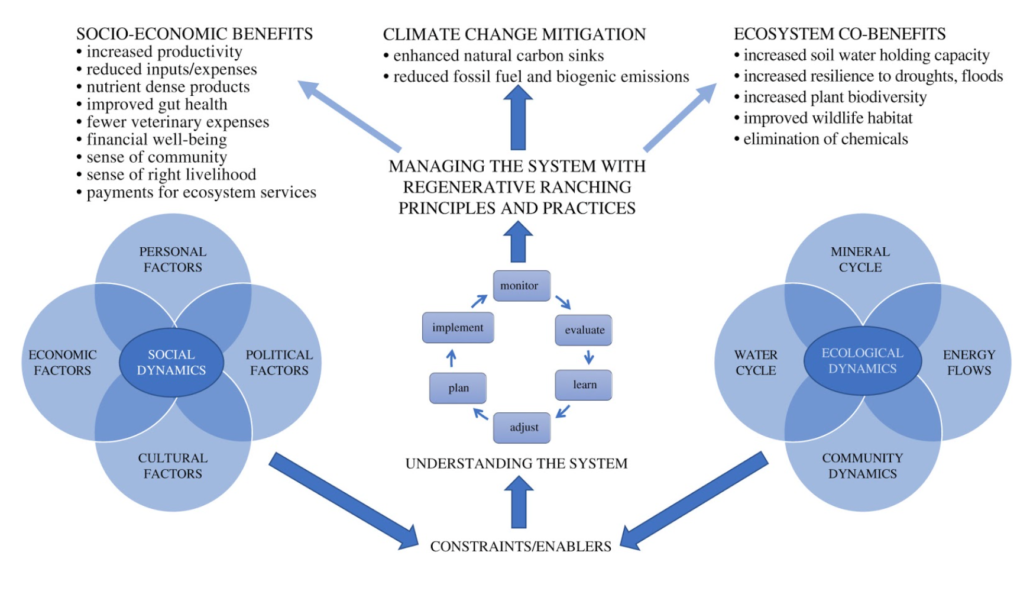 2020 paper in
2020 paper in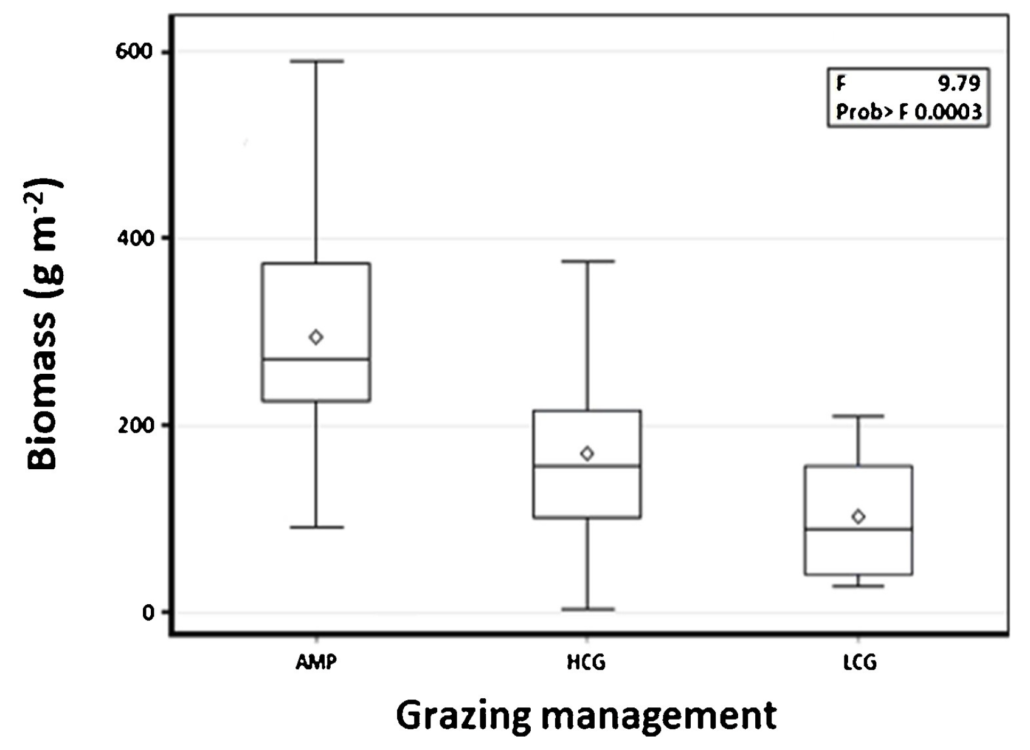 2019 paper in
2019 paper in 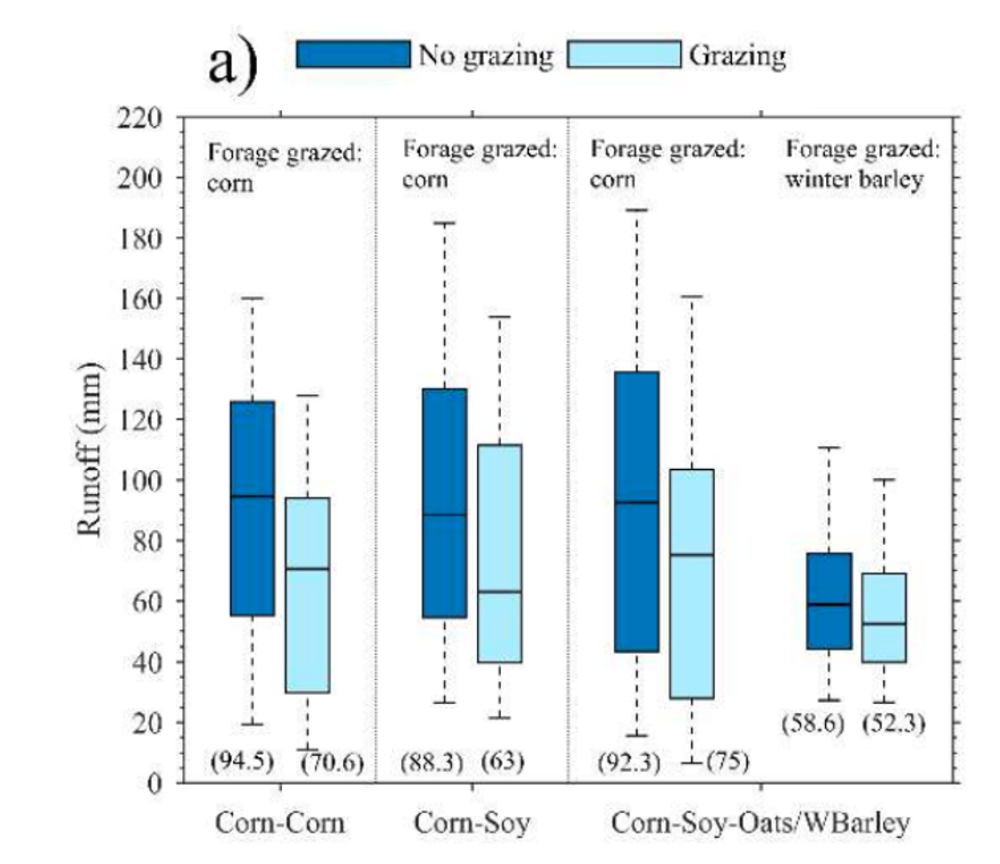 2019 paper in the
2019 paper in the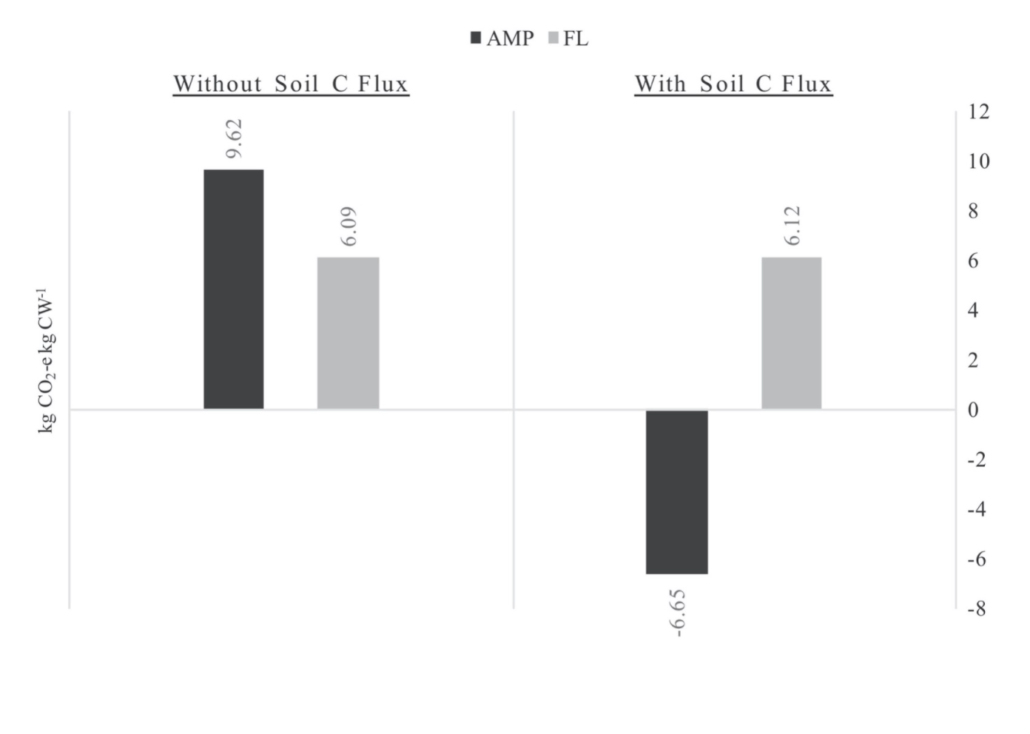 Impacts of soil carbon sequestration on life cycle greenhouse gas emissions in Midwestern USA beef finishing systems
Impacts of soil carbon sequestration on life cycle greenhouse gas emissions in Midwestern USA beef finishing systems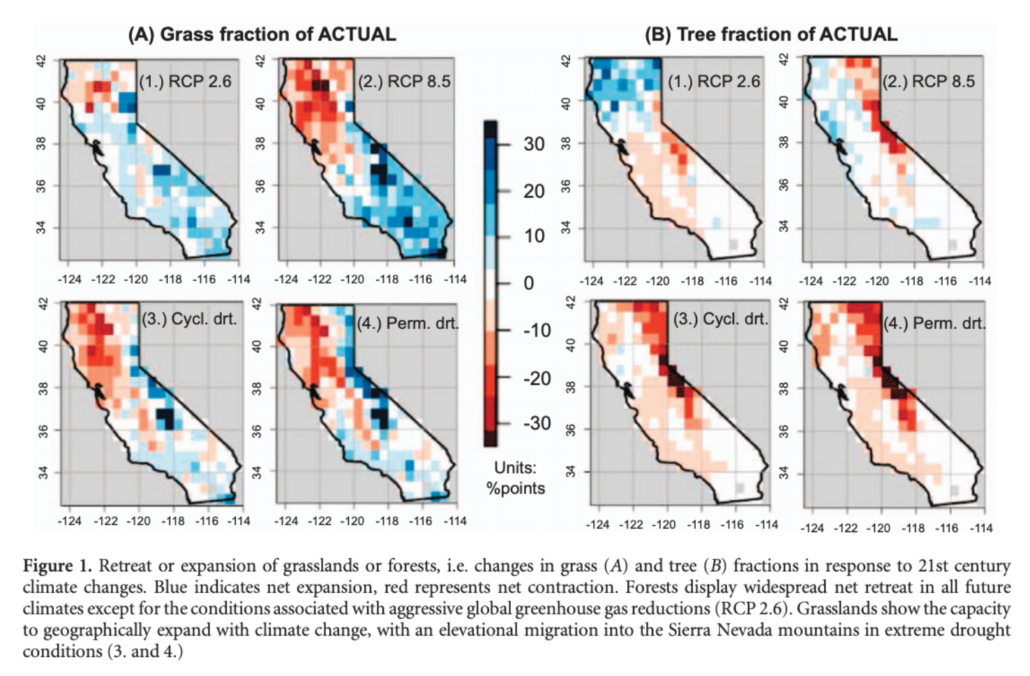 2018 paper in
2018 paper in 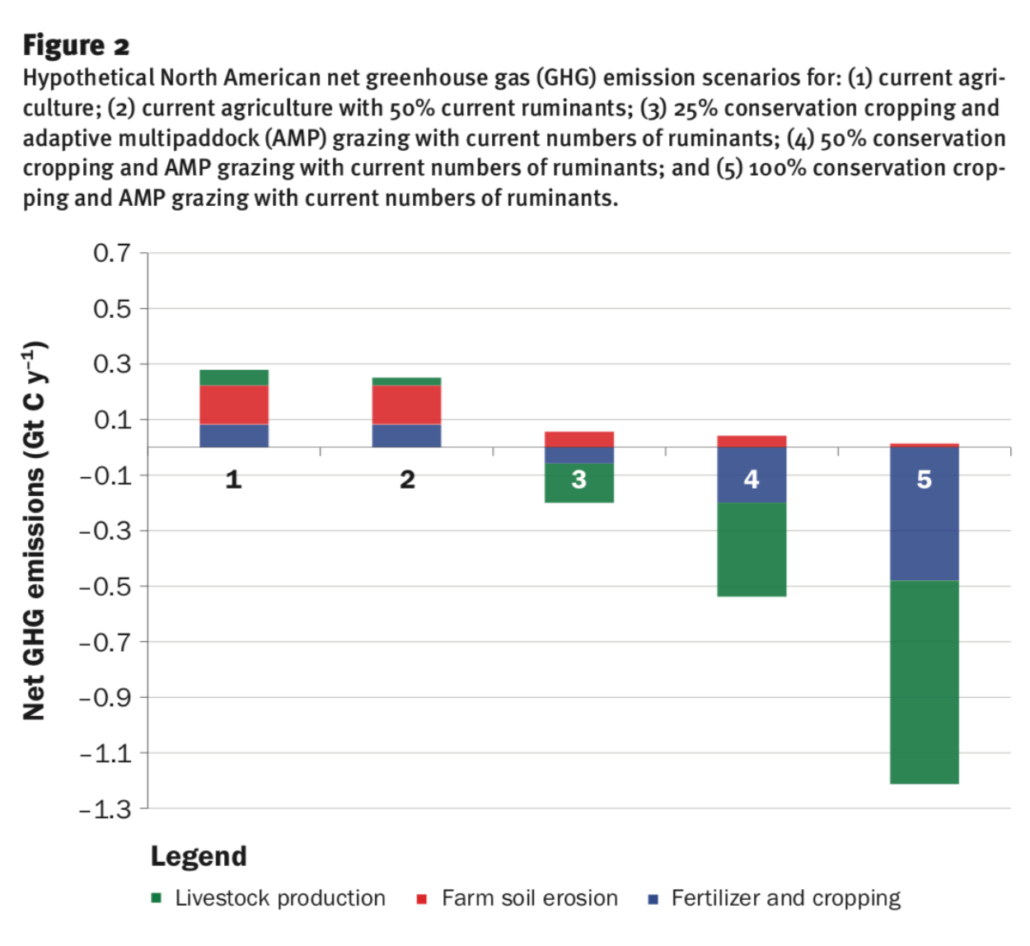 2016 Texas A&M study in
2016 Texas A&M study in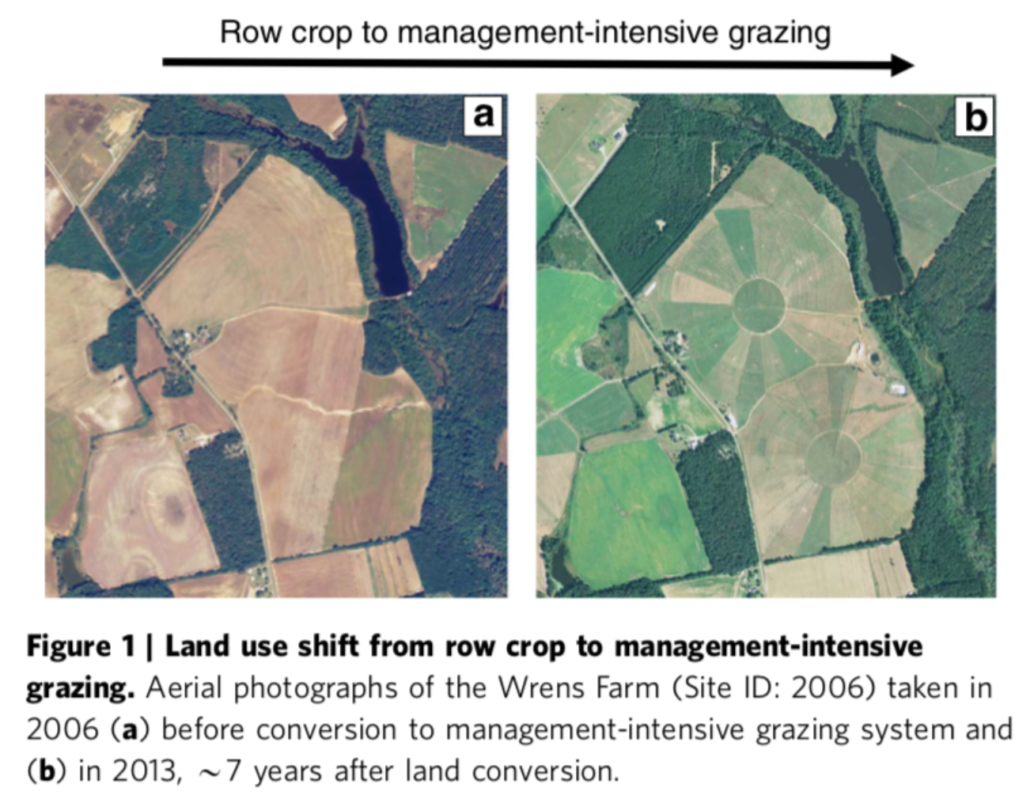 2015 University of Georgia study in
2015 University of Georgia study in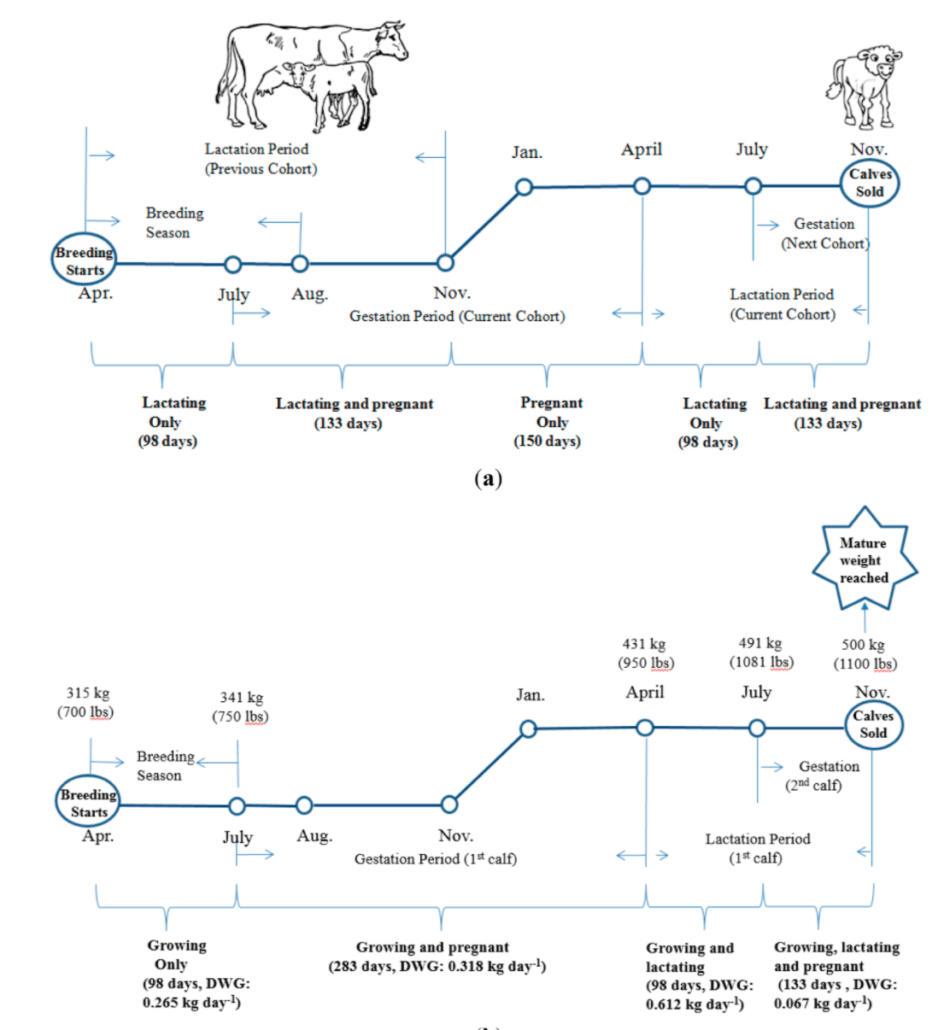 2015 paper in
2015 paper in 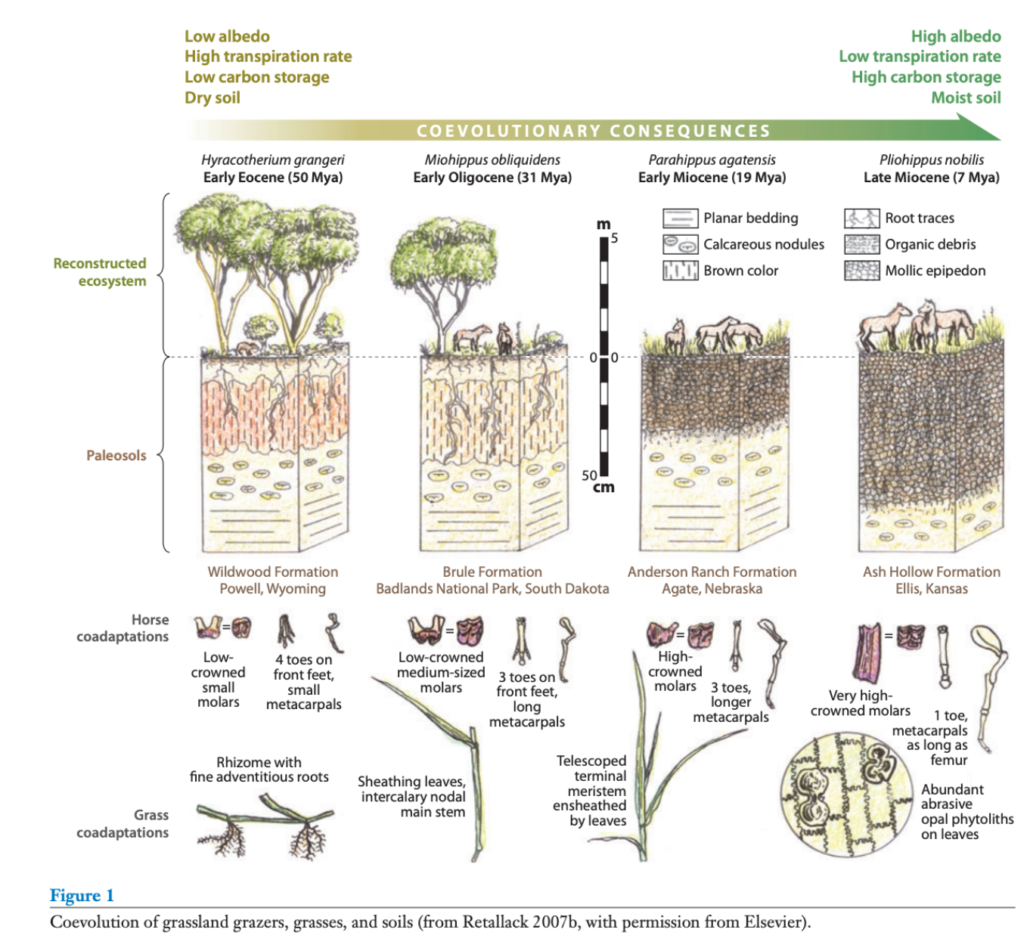 2013 paper in
2013 paper in 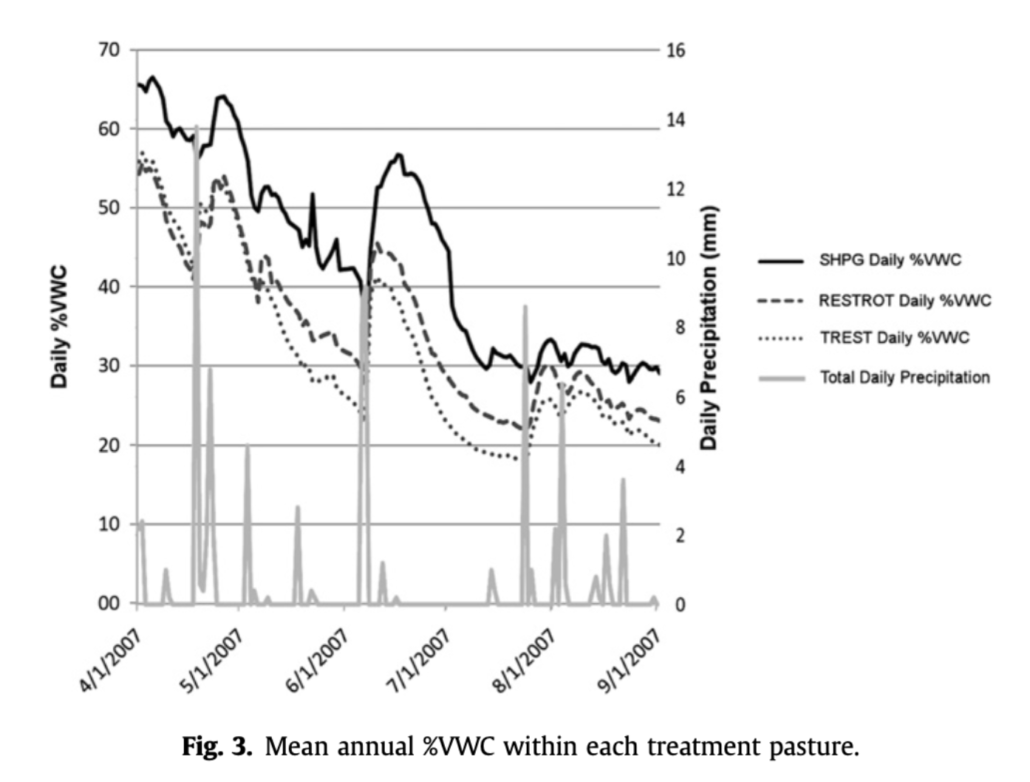 2011 paper in
2011 paper in 